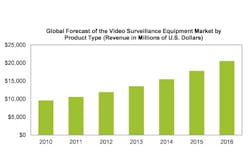Boston Marathon bombing expected to boost video surveillance spending
Despite the impressive growth that was already projected for the global video surveillance equipment market prior to the recent bombing at the Boston Marathon, IMS Research, part of IHS, is predicting that the terror attack will likely drive increased government spending on video surveillance.
Footage from both public and private security cameras proved to be an invaluable tool for authorities during the bombing investigation as they were able to quickly identify the suspects in the case. In fact, just last week, Boston Police Commissioner Edward Davis called for the implementation of a city-run surveillance system and indicated that he would be interested in using aerial surveillance technologies to monitor events such as the marathon in the future.
According to a statement, IMS said that it is the process of updating its most recent forecast of the video surveillance equipment market, which projects worldwide revenue to rise to $20.5 billion in 2016, a 114 percent increase from the $9.6 billion that was spent in 2010.
In addition to government funding and legislation, which play a large part in video surveillance spending, the research firm said that the continued migration from analog to IP will also contribute to increased spending in the market. By 2014, IMS predicts that the global market for network-based video surveillance will reach $7 billion, finally surpassing the analog segment at $6.5 billion.
"The growth outlook of the video surveillance industry is subject to significant variances," said Paul Everett, senior manager, video surveillance, for IHS. "This is because the market is dependent upon the vagaries of several intertwined factors that are difficult or impossible to predict, including economic conditions, government spending and notorious terrorism incidents. While it’s too early to tell exactly what impact the Boston bombing will have, past events—like 9/11 and the London Underground bombings—have led to increased government spending on video surveillance for public spaces, particularly in the transport sector."


